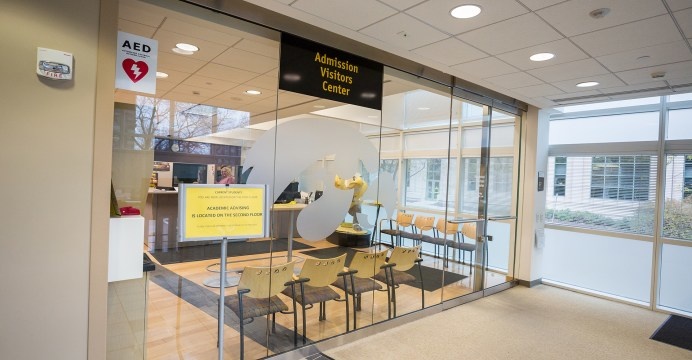
The University of Iowa’s Admissions Visitor’s Center, inside the Pomerantz Center building, on Monday, Oct. 30, 2017 (David Harmantas/The Daily Iowan)
By Sara McElmurry and Juliana Kerr, Guest Opinion, The Daily Iowan
As recently as 2015, Iowa City made national headlines for being the “town where bubble-tea shopsoutnumber Starbucks.” The media chronicled the changes — culturally challenging yet demographically and economically beneficial — from the rapid increase in the number of international students enrolling at the University of Iowa. In 2015, one in 10 Hawkeyes were from China.
Two years later, Iowa City is again making national news: The university is part of a disturbing drop in the number of foreign students coming to study in the United States.
After years of steady growth, international student arrivals have plummeted 7 percent across the country. The UI’s are down 13 percent since 2015. A recent survey finds that students are concerned about the social and political environment in the United States, feel unwelcome, and fear for their safety.
As a researcher focused on immigration in the Midwest and an alum of the UI, we are troubled by these trends. The White House’s travel bans, anti-immigrant rhetoric, and “America First” platform not only run counter to our values, they also compromise universities’ bottom lines and local economies in the process.
Nine of the top 20 U.S. universities with the largest Chinese student populations are Big Ten schools. Chinese Hawkeyes’ $70 million in out-of-state tuition supports the education of their in-state classmates and pumps $100 million into Iowa City’s economy. Students from other countries also bolster enrollment at regional schools and community colleges.
Universities and local communities have long been paying a price for our country’s outdated immigration system.
While international students have been able to study in the U.S. under F-1 visas, there are limited means to stay after graduation. The odds of securing an employer-sponsored H-1B visa are slim: In 2017, the government received 199,000 applications for 85,000 visas.
International students who put their U.S.-minted diplomas to work elsewhere make communities like Iowa City net exporters of global talent — and at great cost. A 2016 study from the Chicago Council on Global Affairs found that the Midwest would gain $3.2 billion in income and $123 million in state income tax by employing foreign-born students in local economies.